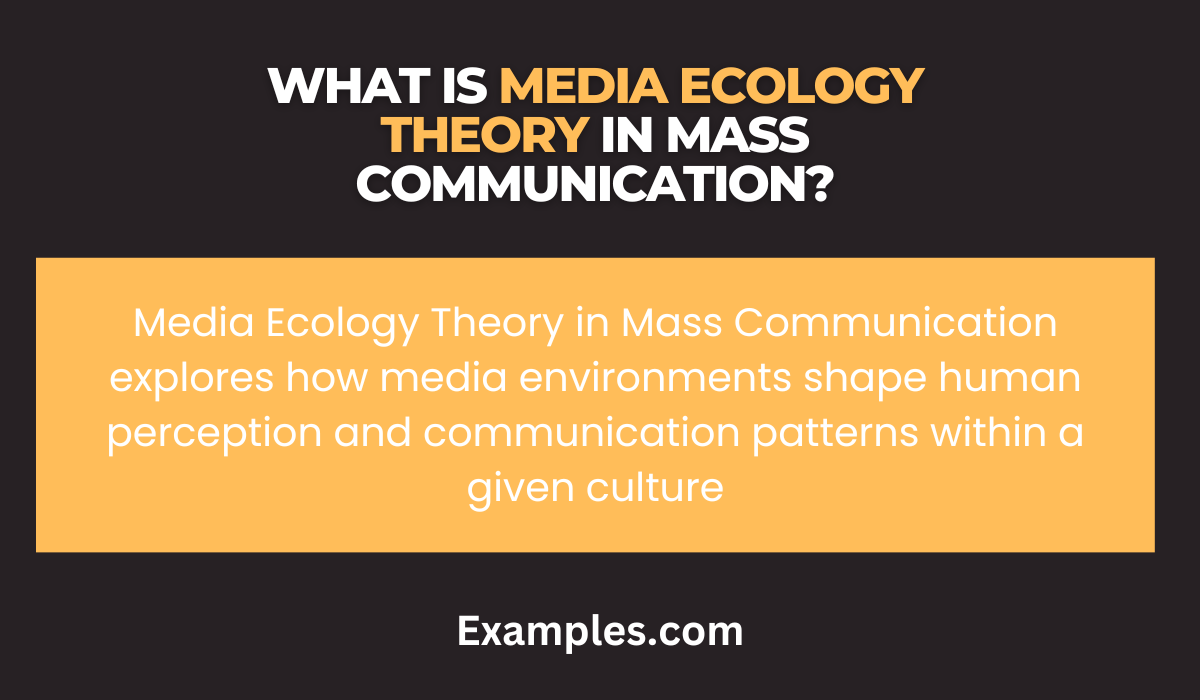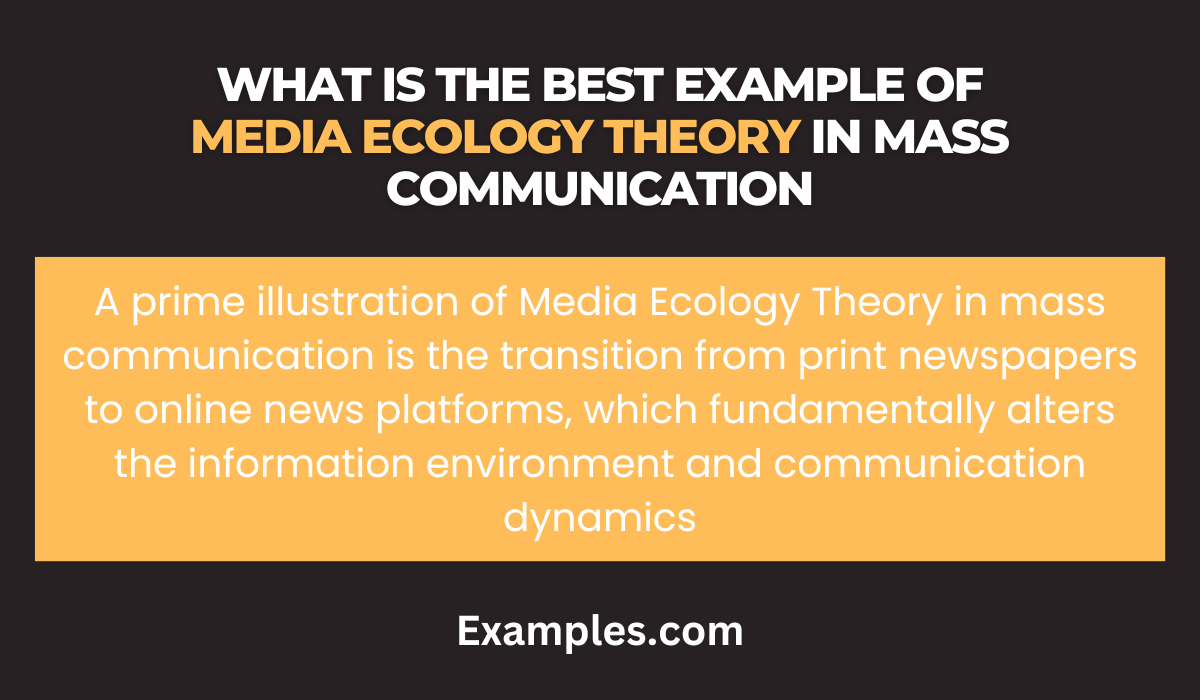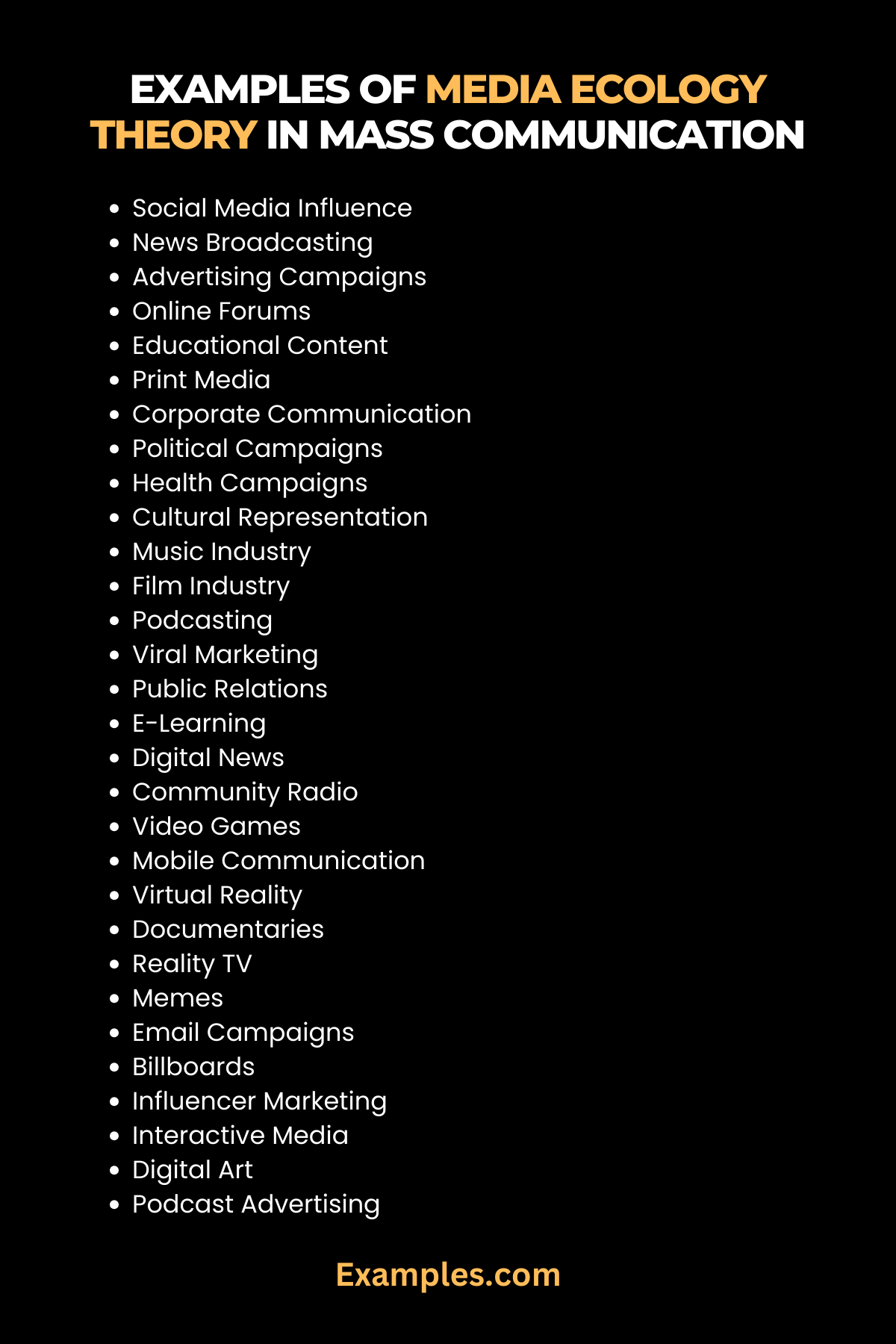29+ Media Ecology Theory in Mass Communication Examples
Delving into the intricate world of Mass Communication, Media Ecology Theory stands out as a pivotal framework. This theory, essential in understanding the dynamic landscape of Mass Communication, offers profound insights into how media influences human perception and interaction. It’s crucial in today’s digital age, where various forms of media, from social media Mass Communication to traditional broadcasting, shape our social realities. This guide explores Media Ecology Theory’s role in Mass Communication, shedding light on its applications and impact. Whether it’s in journalism, digital platforms, or interpersonal communication, this theory provides a comprehensive lens to view the complex interplay of media in our lives.
What is Media Ecology Theory in Mass Communication?
Media Ecology Theory is a fascinating concept in the world of Mass Communication. It revolves around understanding how media influences human perception, understanding, feeling, and value; and how our interaction with media facilitates or impedes our chances of survival. The term “ecology” in this theory implies the study of environments: their structure, content, and impact on people.
At its core, Media Ecology Theory suggests that media acts like environments that affect the way individuals interact, think, and perceive the world. It sees media as not just tools, but as environments that envelop us, creating a symbiotic relationship where we both shape media and are shaped by it. It’s not just about the content that media carries but how the medium itself influences the society and culture.

Key Components
- Environment-Shaping Perspective: Media Ecology Theory views media as environments that dynamically interact with and influence human activities and societal dynamics.
- Medium over Content: It emphasizes the medium itself — whether it’s Television Mass Communication or Social media Mass Communication — rather than the content it carries.
- Cultural Impact: The theory explores how different forms of media shape cultural norms and societal structures.
- Technological Influence: It delves into how technology changes the way we communicate and perceive the world, impacting everything from personal relationships to large-scale social structures.
Applications in Real Life
In Mass Communication, Media Ecology Theory helps understand:
- Mass Communication Characteristics: It explains how different media forms shape communication methods and societal interactions.
- Mass Communication Jobs/Careers: Professionals can leverage this theory to understand the impact of various media forms and evolve their communication strategies accordingly.
- Mass Communication in Advertising: Advertisers use this theory to choose the right medium for the most effective message delivery.
History of Media Ecology Theory in Mass Communication
Media Ecology Theory, a significant concept in Mass Communication, explores the intricate relationship between media, technology, and the human environment. This theory, originating in the mid-20th century, has profoundly influenced various aspects of mass communication, including journalism, broadcasting, and digital media.
The roots of Media Ecology Theory lie in the works of Marshall McLuhan and Neil Postman, who focused on how media technology shapes our perceptions and interactions. McLuhan’s famous phrase, “the medium is the message,” encapsulates the essence of this theory, highlighting the impact of media forms rather than the content they carry. Postman extended these ideas, emphasizing how media technologies influence public discourse and societal structures.
In the realm of Mass Communication, Media Ecology Theory has evolved to address the complexities of digital age communication. With the advent of the internet and social media, the theory has expanded to analyze how these new forms of media reshape public consciousness and social interactions. This perspective is crucial in understanding the dynamics of contemporary mass communication, especially in areas like social media Mass Communication and digital journalism.
The theory also intersects with other mass communication theories like Cultivation Theory and Uses and Gratifications Theory, offering a broader understanding of media’s role in society. It suggests that media not only transmit information but also create environments that alter perception and communication patterns.
What is the Best Example of Media Ecology Theory in Mass Communication
Media Ecology Theory, a concept within the realm of Mass Communication Theories, explores the intricate relationship between media, technology, and human perception. It posits that media influences how individuals think, feel, and act, much like how an environment affects its inhabitants. A compelling example illustrating this theory is the rise of Social media Mass Communication.

1. Social Media: A Landscape of Media Ecology
Social media platforms, like Facebook, Twitter, and Instagram, are quintessential embodiments of Media Ecology Theory. These platforms are not mere channels for information dissemination; they are complex environments that shape and are shaped by human interactions. Here’s how they reflect key aspects of Media Ecology Theory:
2. Transforming Communication Patterns
Social media revolutionized the way information is shared and consumed. It transitioned communication from traditional mass media models to interactive, user-centered platforms. This shift exemplifies the theory’s assertion that media alters communication forms and structures.
3. Influencing Perceptions and Behaviors
Social media platforms influence users’ perceptions and behaviors. The content people engage with on these platforms shapes their understanding of the world, aligning with the theory’s view that media can alter cognitive and behavioral patterns.
4. Echo Chambers and Filter Bubbles
The personalized nature of social media, through algorithms, creates echo chambers and filter bubbles. Users often encounter information that reinforces their existing beliefs, a phenomenon that aligns with the theory’s perspective on how media environments can limit exposure to diverse viewpoints.
5. Shaping Cultural and Social Norms
Social media platforms play a significant role in setting cultural and social norms. Viral trends, popular hashtags, and widely shared content on these platforms often dictate societal conversations, demonstrating the theory’s insight into media’s role in cultural conditioning.
30 Examples of Media Ecology Theory in Mass Communication
Media Ecology Theory, integral in Mass Communication, examines how media and communication processes affect human perception, understanding, feeling, and value. This theory, pivotal in understanding Mass Communication Characteristics, delves into the roles media play in shaping cultural norms and individual behaviors. It’s crucial in the digital era, impacting various Mass Communication Jobs/Careers.

- Social Media Influence: Media Ecology Theory explains the impact of social media on public opinion.
Example: “Social platforms shape societal beliefs, often creating a unified cultural understanding.” - News Broadcasting: Television news alters public perception.
Example: “Broadcasting channels can significantly influence public opinion about political and social issues.” - Advertising Campaigns: Advertisements shape consumer behavior.
Example: “Targeted ads subtly alter consumer preferences and habits.” - Online Forums: Internet forums create micro-cultures.
Example: “These forums foster unique cultural norms influenced by the collective beliefs of their members.” - Educational Content: Educational media shapes learning.
Example: “Educational programs on TV significantly influence children’s learning and development.” - Print Media: Newspapers and magazines set agendas.
Example: “Print media often dictate public discourse and priority of issues.” - Corporate Communication: Internal media shapes organizational culture.
Example: “Corporate newsletters and intranets can unify or divide employee perspectives.” - Political Campaigns: Media in political campaigns shapes voter opinions.
Example: “Campaign ads and debates heavily influence voting decisions.” - Health Campaigns: Media campaigns impact health awareness.
Example: “Public health campaigns in media effectively spread awareness about health issues.” - Cultural Representation: Media representation affects cultural identity.
Example: “Media portrayal of cultures can reinforce or challenge stereotypes.” - Music Industry: Music broadcasting affects trends.
Example: “Radio and online streaming services significantly influence music trends.” - Film Industry: Cinema shapes societal norms.
Example: “Movies often reflect and influence societal values and beliefs.” - Podcasting: Podcasts create niche communities.
Example: “Podcasts gather dedicated listeners around specific topics, influencing their views.” - Viral Marketing: Viral content influences consumer behavior.
Example: “Viral marketing campaigns can rapidly shift market trends.” - Public Relations: PR strategies shape company image.
Example: “Effective PR campaigns can alter public perception of a company.” - E-Learning: Online education models impact learning styles.
Example: “E-learning platforms introduce new ways of learning and information processing.” - Digital News: Online news platforms influence public agenda.
Example: “Digital news sites often determine what topics are viewed as important.” - Community Radio: Local radio impacts community issues.
Example: “Community radio stations play a crucial role in addressing local concerns.” - Video Games: Gaming media affects youth culture.
Example: “Video games significantly influence the hobbies and interests of younger generations.” - Mobile Communication: Smartphones alter communication patterns.
Example: “The prevalence of smartphones has revolutionized how we communicate daily.” - Virtual Reality: VR technology impacts experiential learning.
Example: “VR in media offers immersive experiences, changing our interaction with content.” - Documentaries: Documentaries shape social awareness.
Example: “Documentaries bring attention to social and environmental issues, influencing public opinion.” - Reality TV: Reality shows affect societal expectations.
Example: “Reality TV often sets unrealistic standards for personal life and relationships.” - Memes: Internet memes influence online culture.
Example: “Memes rapidly spread ideas and humor, impacting online cultural trends.” - Email Campaigns: Email marketing influences consumer decisions.
Example: “Targeted email campaigns can effectively sway buyer preferences.” - Billboards: Outdoor advertising impacts brand visibility.
Example: “Billboards in high-traffic areas significantly boost brand recognition.” - Influencer Marketing: Influencers shape consumer trends.
Example: “Social media influencers have a profound impact on their followers’ buying choices.” - Interactive Media: Interactive platforms engage audiences differently.
Example: “Interactive media, like polls and quizzes, actively involve audiences, influencing their engagement.” - Digital Art: Online art movements influence aesthetics.
Example: “Digital art platforms contribute to the evolving trends in visual aesthetics.” - Podcast Advertising: Podcast ads target niche markets.
Example: “Advertisements in podcasts effectively reach specific audience segments.”
Role of Media Ecology Theory in Mass Communication
Media Ecology Theory plays a pivotal role in understanding the dynamic interactions between media, technology, and culture within mass communication. This theory, originally conceptualized by Marshall McLuhan, emphasizes that media influences the way individuals perceive and understand the world. In the context of mass communication, Media Ecology offers insights into how various forms of media shape societal norms, values, and behaviors.
- Medium as the Message: McLuhan argued that the medium through which a message is conveyed is as significant as the message itself. In mass communication, this implies that the platform (be it television, social media, or print) can profoundly influence the audience’s perception.
- Technological Influence: Media Ecology examines how technological advancements alter communication landscapes. For instance, the rise of digital media has transformed traditional mass communication practices.
- Cultural Impact: Media Ecology also explores how media shapes and is shaped by cultural contexts. This is evident in how global media platforms have impacted local cultures and vice versa.
Importance of Media Ecology Theory in Mass Communication
The importance of Media Ecology Theory in mass communication cannot be overstated. It provides a framework for understanding the complex relationship between media, society, and technology.
- Understanding Media Impacts: This theory helps in analyzing how different media platforms impact public opinion, cultural norms, and societal values.
- Adapting to Technological Changes: With the rapid evolution of media technologies, Media Ecology offers a lens to understand and adapt to these changes, especially in fields like public relations mass communication and broadcasting mass communication.
- Guiding Media Practices: For professionals in mass communication jobs/careers, this theory provides insights into ethical media practices and responsible dissemination of information.
How to Use Media Ecology Theory in Mass Communication
Applying Media Ecology Theory in mass communication involves several strategic approaches:
- Analyzing Media Influence: Understanding how different media platforms affect audience perceptions and behaviors. This is crucial in mass communication scenarios/situations where the medium can significantly influence the message.
- Strategic Communication Planning: Utilizing insights from Media Ecology to plan and execute communication strategies. This is particularly relevant in journalism mass communication and social media mass communication.
- Media Literacy Education: Incorporating Media Ecology concepts into education, especially in contexts like mass communication examples in school, to foster critical thinking about media consumption.
In the realm of Mass Communication, Media Ecology Theory stands as a pivotal concept, guiding our understanding of media’s influence on culture and society. This theory, alongside its counterparts like Semiotics in Media Theory, provides crucial insights into how mass communication shapes and is shaped by the cultural environment. It’s essential for students, professionals, and anyone interested in Mass Communication to grasp these theories, as they offer a comprehensive view of the dynamic and ever-evolving landscape of media and communication. Understanding these theories not only enhances our perception of the media’s role in society but also empowers us to navigate and contribute to the field more effectively.



